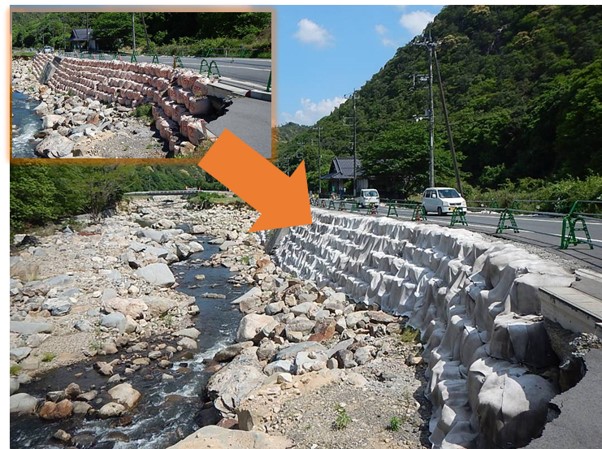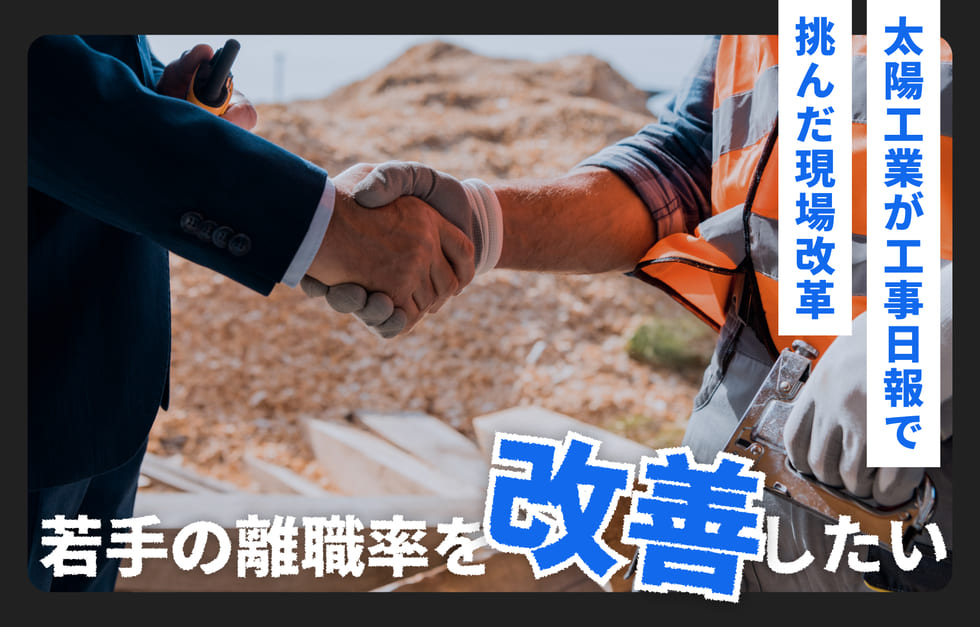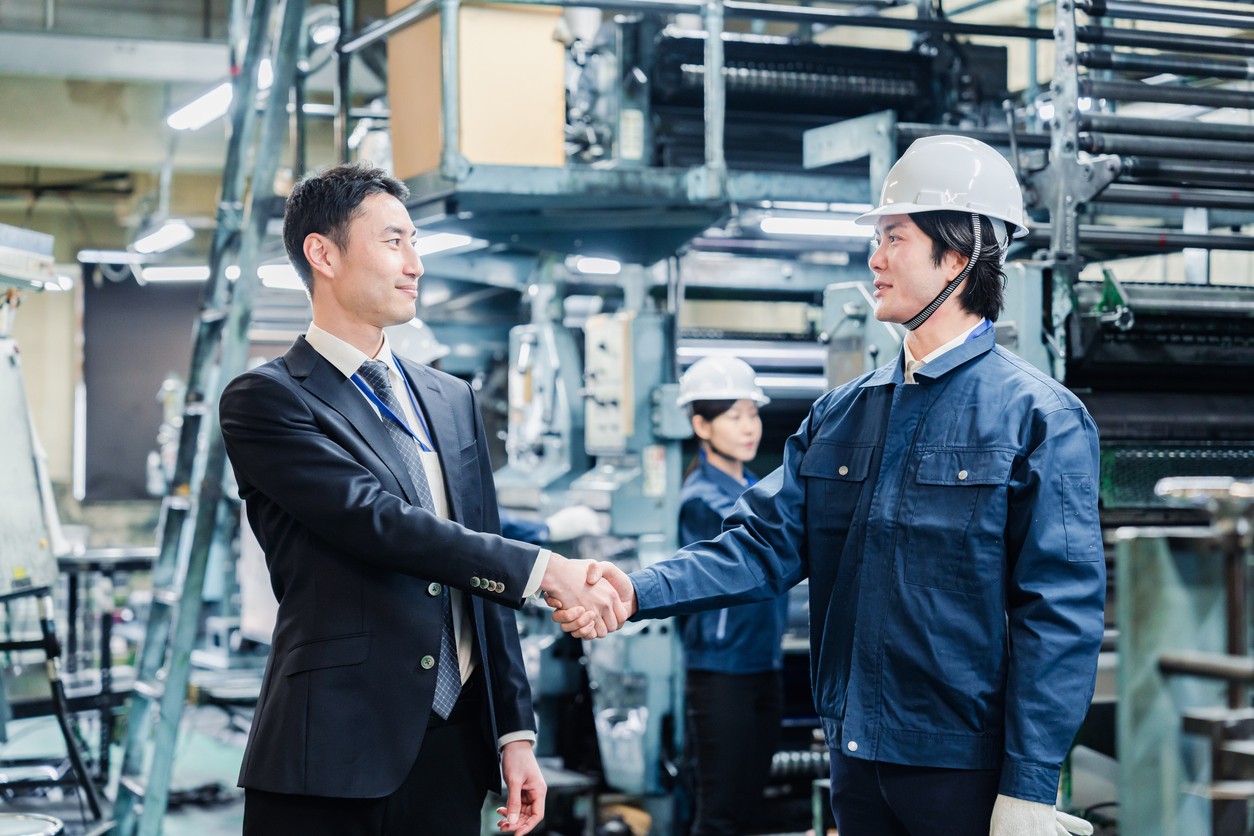

Taiyo Kogyo Column
Functions and Purposes of Medical Negative Pressure Tents that Healthcare Professionals Should Keep in Mind
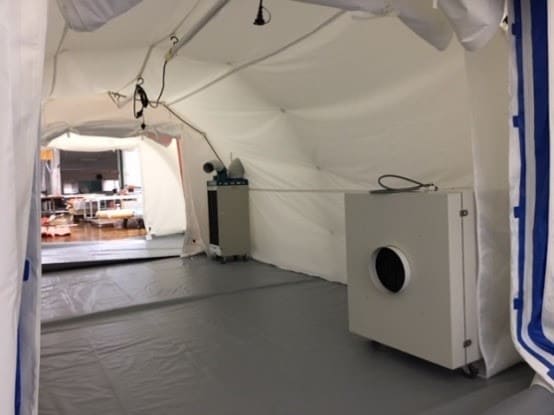
The use of negative pressure tents in the medical field is attracting attention in response to infectious diseases such as the new coronavirus. We will explain in detail the functions and purposes of negative pressure tents for medical use, which can be considered essential equipment for countermeasures against infectious diseases, and promote understanding of their usefulness, as well as provide specific products here.
What is "negative pressure?"
We are increasingly seeing and hearing the term “negative pressure,” such as “negative pressure tent” and “negative pressure room. Negative pressure refers to a state in which the internal pressure of an object is lower than the external pressure. A negative pressure room or tent is a facility in which the internal air pressure is regulated to be lower than the external pressure. Since air flows from higher pressure to lower pressure, air in a negative pressure room does not leak outside. This prevents the spread of infectious agents. (Image of negative pressure: from the website of the Japan Air-Conditioning and Sanitation Contractors Association)
Negative pressure chamber" is necessary for reliable negative pressure isolation
According to the Infectious Diseases Society of Japan, ideal negative pressure isolation requires the following facilities (quoted below) To achieve reliable negative pressure isolation, a front room must be provided, the patient room and front room must have independent air supply and exhaust, and a pressure differential must be created between the corridor and the front room, and between the front room and the patient room, so that air from the patient room does not flow out into the corridor. (omitted) In order to reduce the number of pathogenic microorganisms and dust in the patient room and front room, ventilation of the room air must be done at least a certain number of times. 12 ventilation cycles per hour or more is recommended to achieve the CDC’s recommendation of 99% or more ventilation in a short period of time. If air recirculation is used, at least 2 times/hour of the total ventilation frequency must be ventilated by outside air. When recirculation is used, ventilation of the patient room and the front room should be independent, and the air conditioner should be equipped with a HEPA filter. In addition, CDC guidelines recommend that the air pressure differential in the patient room be maintained at 2.5 pascals or greater [0.01 inch water level]. (End of quote) Some hospitals have “negative pressure rooms” in their facilities as negative pressure facilities that meet these standards. These hospitals exist in approximately 400 locations throughout Japan as “designated medical institutions” under the Infectious Disease Control Law, but not all hospitals have negative pressure rooms. Although the establishment of negative pressure rooms is a highly reliable countermeasure against infectious diseases, it is also extremely costly, requires full-scale construction, and takes time to implement. What is currently attracting particular attention is the medical negative pressure tent, which can be installed quickly and at low cost. What is a medical negative pressure tent?
Outpatient reception in air tent
In the event of a pandemic or other outbreak of infection, hospitals and other facilities will be concentrated with infected and susceptible people, so it is necessary to separate the lines of flow during medical examinations in order to prevent infection. It is not easy in terms of cost to separate lines of flow by building walls or other structures, and on the other hand, the risk of infection cannot be adequately controlled by simply putting up simple partitions. Therefore, the use of “air tents,” which can be easily and quickly set up in any location, for example outside a hospital ward, to separate lines of flow is attracting attention. In addition to the tent itself being effective in preventing the spread of infection to a certain extent as an enclosed space, a significant effect can be expected by adding a negative pressure function.
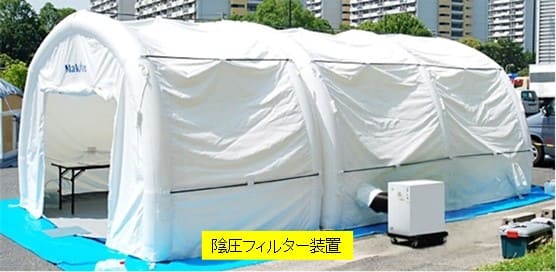
As of March 2020, the expansion of PCR testing systems is being considered in Aichi, Shizuoka, Niigata, and other prefectures in response to the spread of the new coronavirus.This section summarizes the advantages of the drive-through model and the reasons why air tents are used.
Risks and hassles during inspection
First, to prevent nosocomial infection, when a person suspected of having an infection visits an outpatient clinic First of all, when a person with a suspected infection is seen in the outpatient clinic disinfection and changing of clothes. work to prevent nosocomial infection.
- Disinfection… (hospital entrance – waiting area – in the examination room)
- Physician’s change of protective clothing…If the physician changes protective clothing for each person sampled When a physician changes protective clothing for each person to be sampled, carefully so as not to become infected. The change of clothes must be done by the physician. The change of clothes must be done per patient sampling may take up to an hour per person for one person.
Drive-through type reduces risk and hassle
On the other hand, a drive-through type can reduce the time and effort of the above process.
- Patients are not allowed to enter the hospital. Disinfected areas are kept out of the hospital so that people do not to and the disinfection area and the number of disinfection points can be significantly limited, time savings and time-saving.
- examiner is Only change gloves is all that is needed The possibility of If a change of protective clothing is no longer necessary time and time for medical examinations time and time and mental pressure on the doctor time and mental pressure on the doctor. time and mental pressure on the doctor.
- In the first place, the examinee who in the first place Contact with an unspecified number of people in the first place The patient does not have to
(Advantages of air tents)
- Available in all weather conditions All-weather use is possible.
- medical examination Privacy of the person’s vehicle of the patient’s vehicle of the patient’s vehicle the privacy of the patient’s vehicle.
- For drive-through type inspections Air Tent for drive-through inspections installation time is only 10 minutes and ready when you need it. ready when you need it. when you need it.
There are also examples overseas where drive-throughs are being used for more than just inspections. As a result of the postponement of the start of the new term at kindergartens and elementary, junior high, and high schools to prevent the spread of infection caused by the new coronavirus, new students who had not received their textbooks had to study at home without them. To avoid the spread of infection through face-to-face contact, an effort was made to provide new students with textbooks using a drive-through system. For more information on air tents for medical emergencies, please refer to the following article: “Air Tents for Medical Emergencies. ” McQuick Shelter,” a medical air tent ideal for emergency medical care at the site of a disaster.
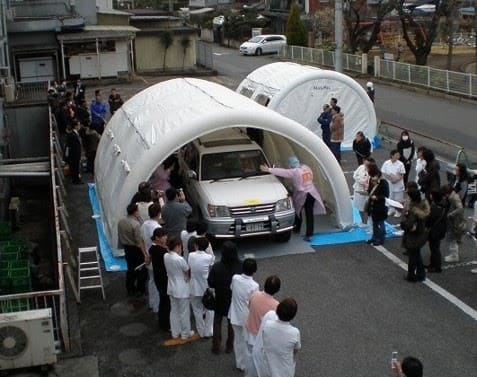
Structure of Negative Pressure Tent
In a negative pressure tent, the air tent has a dedicated connection where a device called a “negative pressure filter system” is installed. This equipment creates a negative pressure room by lowering and maintaining the air pressure inside the tent. This creates air flow and ventilation inside the tent, creating an environment that is less susceptible to infection by medical personnel. The exterior of the tent looks like this. (Appearance of the Negative Pressure Tent)
|
Negative pressure device specifications(EXU03-13)
|
|
| Size | W 700 x D 550 x H 900 (mm) |
| Weight | Approx. 60kg |
| Dust collection efficiency | HEPA filter dust collection efficiency: 99.99% for particles 0.3 μm or larger |
| Treatment air volume | 13m3/min |
| Barometric pressure difference | 10Pa |
| Ventilation frequency | 12 times or more per hour |
| feature | Can be used for both positive and negative pressure Compliant with CDC (Centers for Disease Control and Prevention) guidelines Tool-free replacement of HEPA filter Optional UV sterilization device can be installed without tools |
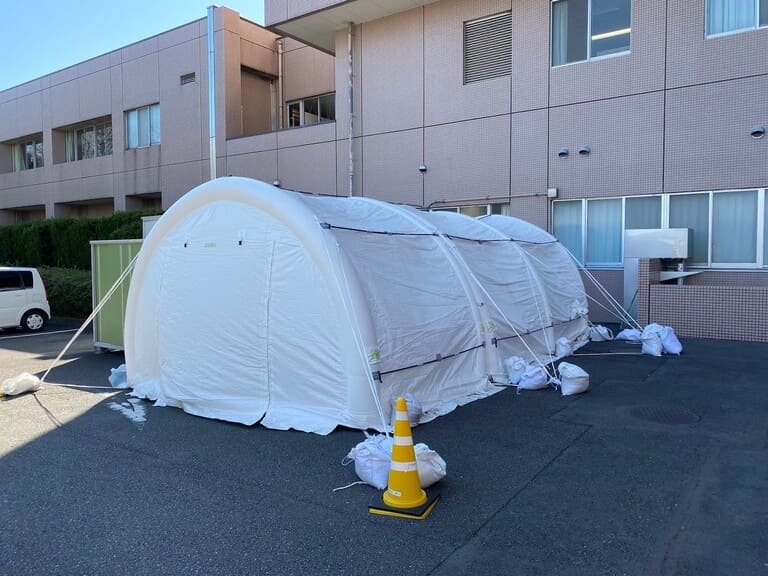
Medical Negative Pressure Tents offer a wide variety of options for use in different environments. A wide range of applications are available to meet the needs of each case, such as installation in summer or winter, use in cold weather, etc., and protection against strong winds.
- Front room (patient waiting area)
- air-conditioning
- Portable heater
- Foldable bed
- Water weight, etc.
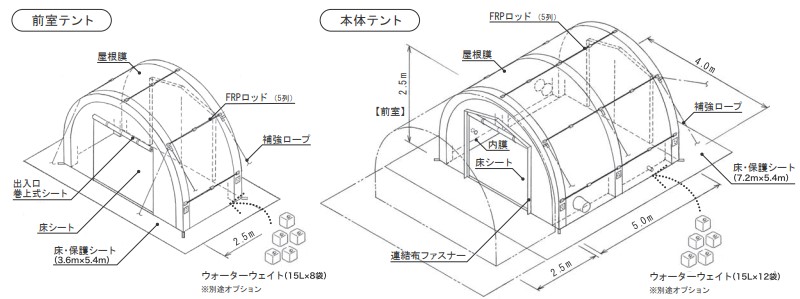
Why is negative pressure tents attracting so much attention in the fight against novel coronaviruses? The purpose of creating negative pressure rooms in infectious disease medical settings can be summarized in three main ways.
Negative Pressure Tent Objective 1: Prevent the spread of infection in a dedicated facility.
Medical Negative Pressure Tents are temporary facilities. For example, in the case of a hospital, it is expected to avoid unnecessary contact between patients and prevent nosocomial infections, etc. by providing a separate flow line and a dedicated treatment space that is completely segregated from non-infected users.
Negative Pressure Tent Objective 2: Negative pressure filters prevent the spread of infectious agents.
As mentioned above, negative pressure tents use a special device to create negative pressure inside the tent, which prevents air inside the tent from leaking outside. This reduces the risk of pathogens inside the tent leaking outside, thereby preventing secondary infections among healthcare workers.
Negative Pressure Tent Objective 3: Quick and flexible installation in an emergency
In the event of a pandemic or other sudden large-scale infection outbreak, a dedicated facility is expected to be quickly set up. Medical negative pressure tents are compact, lightweight, and easy to carry, so they can be stored compactly during normal times, but can be quickly removed, carried to an appropriate location, and easily set up in case of emergency. Installation takes only a few minutes, making it especially useful in emergency situations. Compact storage  (with electric pump) *MQ442A when set up
(with electric pump) *MQ442A when set up
McQuick Shelter, a superior medical negative pressure tent
The McQuick Shelter is a medical-use negative pressure tent with particularly excellent functions, which was introduced in large numbers during the 2009 influenza pandemic. The McQuick Shelter has the following features, and demonstrates high functionality in the medical field where both speed and quality are required to combat infectious diseases.
- 超短時間で立ち上げ可能:最短で約1分程度で立ち上がります。
- 収納も迅速:立ち上げだけでなく、移動などのための収納も迅速です。5分程度で収納が完了します。
- 少ない人数で設置できる:最少で大人2人いれば、設置・収納が可能です。
- 優れた安定性:屋根膜とエアビーム(柱)が一体化しており、形状安定性に優れます。
- 火災対策:膜材には防炎製品を使用しているため、高い防火性を誇ります。
- 現場でメンテナンス可能:一般的なテントは破損すると工場に持ち込んで修理が必要ですが、マク・クイックシェルター現場で簡単にメンテナンス可能です。
- 高い断熱性と対結露性:二重膜仕様の膜材なら、断熱性に優れるため冷暖房効率が高まる他、カビの発生原因になる結露も抑えることができます。
Taiyo Kogyo Corporation: Click here for inquiries about “McQuick Shelter “.
summary
We have introduced the purpose and functions of medical negative pressure tents, which have recently been attracting attention. If you have any of the following three needs in the medical field of infection control, please consider introducing a medical negative pressure tent.
- Dedicated facilities prevent the spread of infection.
- Negative pressure filter prevents spread of infection sources
- Quick and flexible installation in emergency situations
If you would like more information not included in this article, you can contact TAIYO INDUSTRIES, LTD. at the following website Taiyo Kogyo Corporation: Inquire about medical negative pressure tents.
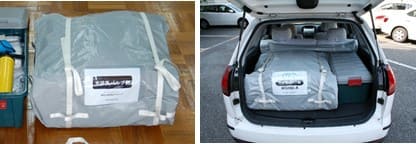


national land enterpriseへの
Contact us
Related Articles
- TOP>
- Taiyo Kogyo Column>
- Functions and Purposes of Medical Negative Pressure Tents that Healthcare Professionals Should Keep in Mind






